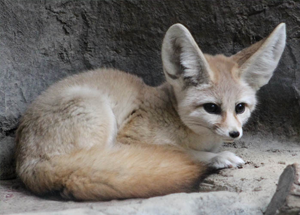
- VisitSupport Happy HollowDONATE TODAYExploreSupport Happy HollowDONATE TODAYLearnSupport Happy HollowDONATE TODAYSupport
-
Today's Hours: 10:00 am to 5:00 pm
Zoo in the HollowFennec fox

Scientific name: Vulpes zerda
Family: Canidae
Order: Carnivora
Class: Mammalia
Range: Northern Africa
Habitat:
Desert Lifespan: Up to 10 years in the wild; up to 12 years in captivityWhat do they look like?
Fennec foxes are the smallest canids (the family that includes foxes, wolves, dogs, coyotes, and jackals), with their weight ranging from one to three pounds. Their average length is about nine to 16 inches with an eight inch tail, and they stand eight inches tall. They have a tiny face and pointed snout. Fennec foxes are well known for having large ears, which serve a dual purpose, helping them to stay cool as well as giving them extraordinary hearing abilities. Their excellent hearing allows them to find prey burrowing underground. Their fur is thick and full, varying in color from reddish cream, to light fawn/sand, or almost white, all of which include a black-tipped tail. Their fur also aids in temperature control, deflecting heat during the day and keeping them warm at night. They even have fur around their foot pads, to protect them from the hot sand.How do they behave?
Fennec foxes are nocturnal (awake and active at night) burrowing animals, which helps them to survive in the extreme temperatures of the desert. They burrow at the base of low hills or dunes where moisture concentrates, keeping their dens cool even in the hottest weather. They are highly social animals, living in small communities of up to ten foxes, which usually consist of a mated pair and their offspring. Males will mark their territory by urinating, and will also become aggressive competitors during mating season. Fennec foxes communicate through a variety of calls including soft warning calls, growls, barks, yelps, squeaks and purrs.What do they eat?
Fennec foxes are omnivores (they eat both plants and meat). They eat mostly rodents, insects, birds, reptiles and eggs, but also plants such as fruits and berries. This species is able to survive with minimal access to water, as their kidneys are adapted to restrict water loss. They are also known to absorb water through food consumption; but will drink water if available. At Happy Hollow, they eat specialized meat pellets, fruits and vegetables!How are they born?
Fennec foxes mate for life and can have up to two litters each year. The kits will reach sexual maturity at six to 10 months, and they breed in January and February. Following a gestation period of about 50 days, the female produces a litter which typically consists of two to five kits, born blind with ears folded over. At about 10 days old, their eyes open and ears begin to lift. Kits are weaned at 61 to 70 days, the male and female work together rearing them.Conservation
The conservation status of fennec foxes is currently listed as Least Concern by the International Union for Conservation of Nature . While fennec foxes are not an endangered species at this time, they are still at risk due to a combination of factors such as capture for the exotic pet trade and poisoning due to human-carnivore conflicts. One organization focusing on the conservation of fennec foxes is the Sahara Conservation Fund (SCF). The SCF aims to preserve the habitat of fennec foxes and other animals that call the Sahara Desert home. You can help fennec foxes by leaving these beautiful animals in the wild, rather than keeping them as pets. Due to large spatial needs and social interaction, these animals are much better suited for life in the wild. If you are looking for a new pet, check out your local humane society, there you will find people who can help you make the proper pet choice.
Zoo on the Hill
Located across from the Keep-Around Carousel is the Zoo on the Hill. Learn about wildlife up close during daily meet-and-greets, leap like a lemur on the playground, brush and feed the goats,, or take a peek inside Doc’s Critter Care building and the Ranch House. Double-H Ranch features a combination of animal exhibits, including giant anteaters and red ruffed lemurs, as well chickens and domesticated animals that are docile enough to touch.
See Animals
Education Ambassadors
From camps and classes to scout badges and sleepovers, Happy Hollow education programs have something for everyone! The zoo education program offers a broad range of hands-on, engaging programs and public presentations featuring education ambassador animals. These encounters are designed to connect you to wildlife and the conservation of their habitats around the world.
See AnimalsVisit Us Today
Plan an unforgettable experience at San Jose’s family-friendly park and zoo.
Learn More